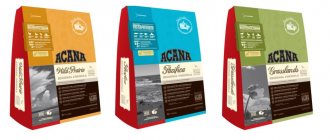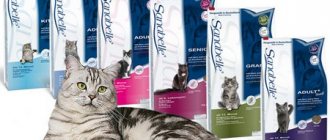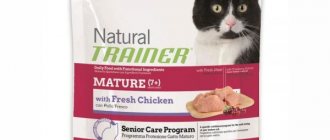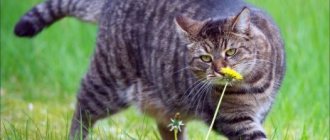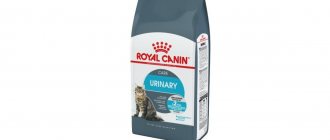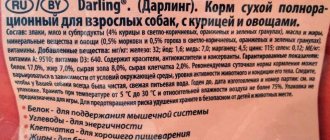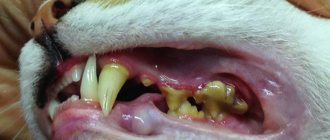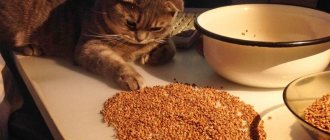Pet owners have long appreciated the convenience of using ready-made food. With their appearance on our shelves, the need to prepare food for dogs, cats and other domestic animals on our own has disappeared. The feeding process has now become simple and convenient. It is enough to pour a certain amount of granules into a bowl so that the pet receives all the nutrients necessary for its body (as the manufacturers claim). Most pet owners buy food for their pets in large packages, which is much more economical. And some people simply stock up on different types of such products or buy them on sale. But not everyone knows how and where to store dog and cat food so that it does not lose quality throughout its shelf life.
Problem of choice
At the time of purchase, you should always pay attention to the condition of the packaging. It should be slightly swollen, which indicates its complete tightness. Inside the bag there is nitrogen, which the manufacturer uses as a preservative. When the packaging easily rolls up, this indicates a violation of its seal. There is no longer any nitrogen inside, and the process of oxidation of the product has begun as a result of exposure to oxygen. In such a pack, the storage of food for dogs and cats will be very short, so it is not worth buying it.
Buying loose feed is undesirable for the same reason. Nobody knows the degree of its freshness. This means that the quality of the product will be very questionable.
The manufacturer indicates how long dry food can be stored on the packaging. Usually it is 1 – 2 years in closed form. For a product containing vitamin E – 6 months. Once the package is opened, this time is significantly reduced.
How to store dry food
Storing dry pet food in sealed containers does not have to be in the refrigerator. It is enough to place it in a cool, dry place, away from light. This could be a cupboard or pantry where the product can sit until its stated expiration date.
Once the package is opened, the main goal is to minimize the exposure of the contents to oxygen. To do this, part of the granules is poured into another container, and the rest is left in the original packaging. At the same time, as much air as possible is removed from it and sealed hermetically. It is better to twist the bag in several layers in the place where it was opened, and then secure the edge with clothespins or paper clips.
How to properly store dry food after opening the package?
- It is very important to keep it in a dry, cool place.
- Do not leave a bag of granules near hot radiators or other heat sources.
- It is also contraindicated to simply store it on a windowsill exposed to sunlight.
Optimal storage conditions for dry animal food:
- temperature +18°С – +20°С,
- air humidity – 70%.
At higher temperatures (+23°C - +26°C), the shelf life of dry food will be 1 month. Under such conditions, the product quickly oxidizes and loses nutritional value.
It is not recommended to store pet food in the freezer. When frozen, it loses its taste and beneficial qualities.
Wet food - storage secrets
- Before you open canned food or pouches, keep them in a dry, cool place. Make sure that they are not exposed to direct rays of the merciless sun.
- If you have opened canned food, be sure to transfer the contents from the tin into a glass jar with a lid or into a special plastic container. Food should not be stored in an open tin can! Otherwise, the jar will begin to oxidize and release harmful substances into your pet’s food.
- The contents of canned food or pouches can be stored for 24 hours, but only in the refrigerator.
- If you doubt that your dog or cat will finish open food in a day, then you can freeze the food. It is advisable to do this immediately after opening the jar. Otherwise, you will have to throw it away after the expiration date so that the pet does not get poisoned.
How to store dry food
The feed storage container can be glass, porcelain, plastic or tin. It is very important that it has the ability to close hermetically. It is best to use a screw cap.
There is no need to use containers that are too large. spacious they , the more oxygen will get inside each time the lid is opened. In a small jar, the food will remain fresher, as it will be eaten by the animal much faster.
- A dry food storage container made of plastic has a number of advantages. This material is quite lightweight, comfortable and inexpensive. Moreover, such containers must be intended for food products. The negative aspects of plastic containers are their rapid contamination and the fact that they are able to absorb the odors of the contents, which cannot be said about glass containers.
- Tin or aluminum containers also have their disadvantages. The metal may react with some components of dry food. This negatively affects their taste. Therefore, it is better to choose containers that have a protective coating that prevents oxidation.
- Glass or porcelain food containers are the most environmentally friendly. It does not affect the quality of the contents in any way and is easy to clean. Transparent jars of food should be kept in a dark place, but for porcelain jars this measure is not necessary.
Where to store - container and place
As I have already described, it is better to pour part of the food, 500-800 grams, into a container and give it to your pet every day. The rest should be sent for storage in original packaging.
You can choose different containers for storage - glass, porcelain, plastic, tin. The main condition is that each container must have a tightly closing ground or screw-on lid.
Do not use containers that are too large - the larger the volume, the more air will enter the feed each time. The smaller the volume, the faster the pet will eat it, the fresher the food will be. It simply won't have time to deteriorate.
Let's look at the pros and cons of different container options.
Plastic container . The main advantages are that it is light, comfortable and cheap. You won’t break it, it’s convenient to take it with you if, for example, you go with your cat to the country for a few days in the summer. For a long time I used plastic containers, but over time I replaced them. The fact is that a plastic jar quickly gets dirty and is also saturated with the smell of food, which is difficult to clean. I also noticed that food is stored worse in plastic than, for example, in glass. This was detected both by the smell of the food and by the cat’s reaction. Yes, yes, my cat categorically refuses to eat rancid, oxidized food. You can easily check the quality of the product on it.
If you do choose plastic, it must be food grade. Do not store food in containers intended for storing household items and other inedible items. To make sure that the plastic in front of you is food grade, look at the bottom of the container - there should be a spoon and fork icon there - either on the plastic itself or on the label. Non-food grade plastic can leach toxic compounds into food.
Glass jar is the most preferred option
Tin container . Tin containers, in particular aluminum, have the following disadvantage - aluminum reacts with food and can change the taste of the product (the same applies to dishes for people). If you choose a tin container with oxidation protection (all modern metal utensils for people have this protective layer and are therefore safe), then this problem will disappear by itself.
Glass or porcelain containers. Both options are considered the most preferable. Now I use glass containers with a plastic lid. Such containers can be bought in any dishware department - these are jars for storing cereals. In glass and porcelain, food is stored longer, it does not lose its smell, the smell does not eat into the walls of the dish, and the animal is full and satisfied.
Store the containerized food in a dark and dry place, away from sunlight, to avoid overdrying and mold formation (in case of high humidity).
Other types
How and where to store wet food? Such a product must be in sealed packaging. Therefore, it is produced in small packages designed for several feedings of the animal.
The shelf life of food in a package sealed by the manufacturer is 2–3 years, which is 2 times longer than that of dry food. But after opening the package, the product should be used within the next 24 hours.
Food can be stored in a closed package in a cool, dark place (the bottom shelf of a kitchen cabinet, a cool, dry pantry), and after opening - only in the refrigerator. In this case, the unused part of the product is transferred to a plastic or glass container that can be hermetically sealed.
Before feeding the animal, the contents of the container are left for some time at room temperature so that it is not too cold.
It is best to purchase wet food in packages designed for one feeding. Then there will be confidence in the freshness of the product that the animal receives. Large packages are suitable for owners of several cats (dogs, etc.).
If wet food remains uneaten and remains in your pet's bowl for more than 4 hours, it should be thrown away. This time is quite enough for the development of harmful bacteria. For the same reason, you should thoroughly wash your pet’s bowl after each feeding.
How long does an opened package last?
Even if you purchased food whose expiration date has not yet expired, you should calculate whether your cat will have time to eat the entire contents of the package before it expires. Even in original packaging, many useful substances are destroyed over time, primarily vitamins.
In addition, the fats contained in dry food granules gradually oxidize, and this process accelerates upon contact with air, that is, after opening the package. Gradually, the food acquires an unpleasant smell and taste, and cats usually refuse to eat it. Moreover, when the oxidation process goes far, harmful substances begin to form in the granules and consuming such food becomes simply dangerous.
According to the manufacturer's recommendations, the shelf life of an opened package of dry food is approximately three months, but this period may be shortened by exposure to direct sunlight, high temperature or humidity. In addition, as already mentioned, the organoleptic characteristics of the feed deteriorate over time. Many cat owners notice that their pets are reluctant to eat food whose packaging has been opened more than six weeks ago, so we recommend buying packages that cats can eat in a month.
Tightness plays the most important role in dry food storage. Acana and Orijen feed packages have a zip-lock fastener, which allows the granules to be stored in their original packaging after opening. But you can also place the packaging itself in a plastic or tin container, or pour the granules into any other container convenient for storage, the main condition being light-tightness and a tight lid. Remember to wash your dry food container regularly. If there is still food left in the container, and you have already bought a new package, you should not pour its contents on top - first feed the remainder and wash the container.
You should not store dry food in the refrigerator, and especially not in the freezer - freezing will not have the best effect on dry food. Dry food in a package or other container should be stored at room temperature in a cool, dry place out of direct sunlight, such as on a shelf in a kitchen cabinet.
Useful tips
If pellets or uneaten wet meat pieces are transferred to glass containers, the food name portion of the container should always be retained. The date of opening must be indicated on it in order to know exactly the expiration date of the product.
If, as a result of feeding an animal, problems arise, it will always be clear which manufacturer’s food caused this. Then in the future it will be possible to avoid repeating mistakes.
Considering how long open dry food can be stored, it is purchased in packages of the appropriate size so that the animal does not have to eat an expired product. You should not buy loose feed at all: it may be past its expiration date.
Before storing pet food in a container, it is better not to remove it from the manufacturer's package.
How long can food be stored after opening the package?
Even with strict adherence to all the rules, open dry food is stored for no more than 4-6 weeks, after which even antioxidants can no longer cope with the continuous oxidation of fats and the destruction of vitamins and nutrients. And what is especially critical in storing dry cat food is the weathering of volatile compounds, which form the smell of the product.
Picky animals often refuse to eat food that doesn’t smell, so you need to buy a package of a size that your cat can handle in a maximum of a month and a half.
We also advise you to pour the food needed for two to three days into a separate hermetically sealed container so as not to open a large bag every day - this way air will penetrate into it less often, which can prolong the shelf life of the food.
How to tell if food is spoiled
Eating stale food can lead to health problems for your pets. Therefore, many are interested in how to understand that a product is spoiled?
Storing dry food in a damp place for a long time leads to the appearance of an unpleasant odor, mold and swelling of the granules.
When stored for a long time in a very dry room, on the contrary, the granules become too hard, which is dangerous for pets. If the animal chews them with difficulty, they are spoiled.
When food comes into contact with air for a long time, it acquires the smell of rancid fat. This product should not be given to an animal.
Wet food made from bloated bags should also not be offered to your pets.
When, after feeding, there are pieces of meat left in the bowl that quickly dry out and darken, you should reduce the portion size in the future. It is better to throw away the spoiled product immediately before the animal decides to finish it.
It is strictly forbidden to feed domestic animals with a product that contains insects or their larvae.

